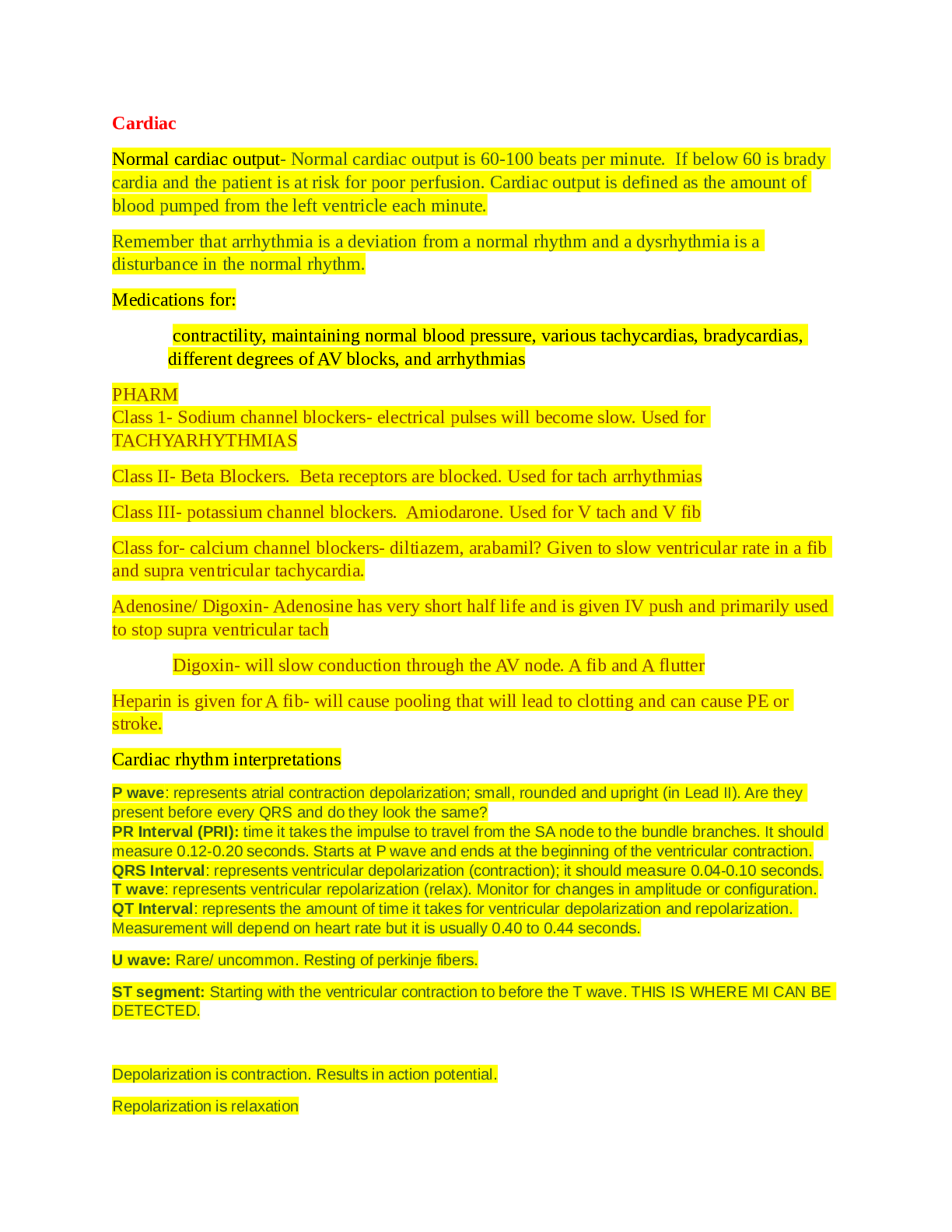*NURSING > EXAM REVIEW > NSG 6020 Final Exam Review 2021-GRADED A+ (All)
NSG 6020 Final Exam Review 2021-GRADED A+
Document Content and Description Below
NSG 6020 Final Exam Review 1. Normal breast changes with menstrual cycle Fibrocystic breast changes include a variety of histopathological variations, with fibrotic thickening often paired with the... development of cysts. However, this condition is considered benign and/or physiological rather than pathological. The nodularity is usually associated with tenderness. The nodularity and tender- ness are both cyclic in nature, fluctuating with the menstrual cycle. The symp- toms are usually most severe just before menses. The size and/or number of lumps or nodules may fluctuate during the cycle. The changes are usually bilateral. Breast discharge may also occur cyclically before menses and is usually serous. Breast pain—mastalgia or mastodynia—is the most common breast complaint. The most common type of breast pain is cyclic mastalgia, which occurs in pre- menopausal women and is associated with hormonal fluctuations. In contrast, noncyclic breast pain is often unilateral and may be described in many ways, including sharp, burning, and aching. Many benign breast changes, including cysts, mastitis, trauma, abscess, duct ectasia, and fibroadenoma, are associated with noncyclic mastalgia. Women who experience cyclic mastalgia usually have onset as a teen or young adult. The pain associated with hormonal fluctuation most commonly occurs during the second half of the woman’s cycle. The variability of the signs and symptoms is identified with a symptom calendar. The pain is typically poorly localized, bilateral, and nonspecific. It may be accompanied by a sense of breast fullness. The examination may identify the multiple, bilateral nodularities associated with fibroadenomas or fibrocystic changes.Diagnostic Studies The breast pain diary identifies the cyclic nature of the pain and its association with the menstrual cycle. A mammogram or ultrasound reveals no indication of malignancy or mass other than fibroadenomas or cysts. 2. Risk factors associated with osteoporosis Age: Post-menopausal, Gender: women, family history, small body frames, Ethnicity: Asian and Caucasians, smoking, alcohol, hyperthyroid & hyperparathyroid, steroids, and a history of bone fractures, low calcium & vit D, and eating disorders. 3. Findings in a peripheral vascular assessment Dependent edema, non-painful, hyperpigmented thick skin, high risk of stasis ulcers, thrombophlebitis, varicose veins. Pain or weakness that occurs in the calves, and sometimes the thighs or buttocks, with exercise and dissipates at rest is most likely related to PVD. The onset of the pain is gradual and may not even occur until some time after exercise. The pain tends to be a constant ache that may last hours to days. 4. Signs and symptoms of heart failure, and venous thrombosis. Heart Failure: The three most common symptoms of HF are dyspnea with exertion or rest, orthopnea, and edema. Patients also may complain of nonproductive cough and fatigue. Signs include ankle or pretibial edema, rapid weight gain caused by fluid retention, bibasilar crackles, tachycardia with a gallop rhythm, and hypoxia. Left ventricular failure is most commonly characterized by dyspnea on exertion, cough, fatigue, orthopnea, PND, cardiac enlargement, crackles, gallop rhythm, and pul- monarycongestion. Right ventricular failure is more commonly characterized by dependent edema, elevated venous pressure, hepatomegaly, and possibly ascites. Although left and right failure can occur independently, they often occur together, and left ventricular failure is the most common cause of right ventricular failure. Venous Thrombosis: The signs and symptoms of DVT include swelling, tenderness, and inflamma- tion of the calf and often pain with ambulation. In about 50% of the cases, symptoms are absent and pulmonary embolism may be the first sign. Pul- monary embolism should be suspected with a complaint of acute onset of short- ness of breath, chest pain, or hemoptysis in a person with any of the above risk factors. Preventive measures include early mobilization of postsurgical patients, raising the foot of the bed, and antiembolism hosiery, especially for patients who have a history of venous insufficiency and for people traveling long distances by plane. 5. Signs and symptoms of genu varum, genu valgum, pes planus & metatarsus adductus Genu varum: wide-based gait and a bowlegged Genu valgum: knock-kneed Pes planus: flat feet Metatarsus adductus: Front art of foot turns inward: 6. Signs and symptoms bulla, wheal, nodule & papuleBulla: Large blister containing serous fluid. Lesion is raised >1cm and fluid filled.Wheal: Area of localized dermal edema that comes and goes within a period of 1-2 days. “Urticaria” Looks like hives. Nodule: Larger and deeper than a papule Papule: Raised lesion less than 1cm. NOT fluid filled. 7. Educational information that should be shared with breast-feeding mothers. 8. What is the meaning of gravida & para? [Show More]
Last updated: 2 years ago
Preview 1 out of 33 pages

Buy this document to get the full access instantly
Instant Download Access after purchase
Buy NowInstant download
We Accept:

Reviews( 0 )
$11.00
Can't find what you want? Try our AI powered Search
Document information
Connected school, study & course
About the document
Uploaded On
Aug 07, 2021
Number of pages
33
Written in
Additional information
This document has been written for:
Uploaded
Aug 07, 2021
Downloads
0
Views
99




.png)


.png)





.png)











